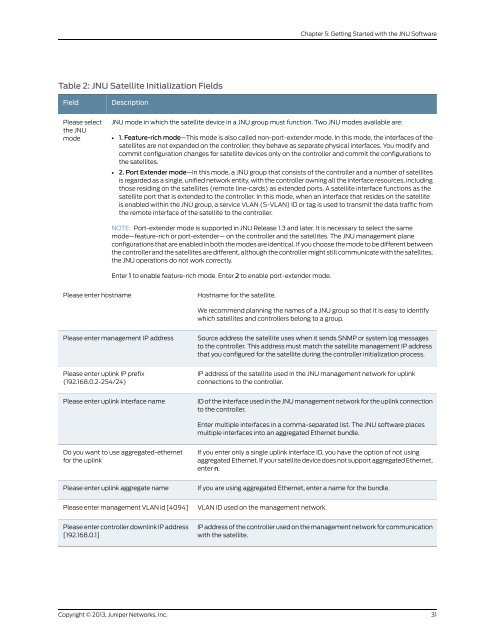Designing and Implementing a Junos Node Unifier Network
Designing and Implementing a Junos Node Unifier Network
Designing and Implementing a Junos Node Unifier Network
You also want an ePaper? Increase the reach of your titles
YUMPU automatically turns print PDFs into web optimized ePapers that Google loves.
Table 2: JNU Satellite Initialization Fields<br />
Field<br />
Please select<br />
the JNU<br />
mode<br />
Description<br />
Please enter hostname<br />
JNU mode in which the satellite device in a JNU group must function. Two JNU modes available are:<br />
• 1. Feature-rich mode—This mode is also called non-port-extender mode. In this mode, the interfaces of the<br />
satellites are not exp<strong>and</strong>ed on the controller; they behave as separate physical interfaces. You modify <strong>and</strong><br />
commit configuration changes for satellite devices only on the controller <strong>and</strong> commit the configurations to<br />
the satellites.<br />
• 2. Port Extender mode—In this mode, a JNU group that consists of the controller <strong>and</strong> a number of satellites<br />
is regarded as a single, unified network entity, with the controller owning all the interface resources, including<br />
those residing on the satellites (remote line-cards) as extended ports. A satellite interface functions as the<br />
satellite port that is extended to the controller. In this mode, when an interface that resides on the satellite<br />
is enabled within the JNU group, a service VLAN (S-VLAN) ID or tag is used to transmit the data traffic from<br />
the remote interface of the satellite to the controller.<br />
NOTE: Port-extender mode is supported in JNU Release 1.3 <strong>and</strong> later. It is necessary to select the same<br />
mode—feature-rich or port-extender— on the controller <strong>and</strong> the satellites. The JNU management plane<br />
configurations that are enabled in both the modes are identical. If you choose the mode to be different between<br />
the controller <strong>and</strong> the satellites are different, although the controller might still communicate with the satellites,<br />
the JNU operations do not work correctly.<br />
Enter 1 to enable feature-rich mode. Enter 2 to enable port-extender mode.<br />
Please enter management IP address<br />
Please enter uplink IP prefix<br />
(192.168.0.2-254/24)<br />
Please enter uplink interface name<br />
Do you want to use aggregated-ethernet<br />
for the uplink<br />
Please enter uplink aggregate name<br />
Please enter management VLAN id [4094]<br />
Please enter controller downlink IP address<br />
[192.168.0.1]<br />
Copyright © 2013, Juniper <strong>Network</strong>s, Inc.<br />
Hostname for the satellite.<br />
We recommend planning the names of a JNU group so that it is easy to identify<br />
which satellites <strong>and</strong> controllers belong to a group.<br />
Source address the satellite uses when it sends SNMP or system log messages<br />
to the controller. This address must match the satellite management IP address<br />
that you configured for the satellite during the controller initialization process.<br />
IP address of the satellite used in the JNU management network for uplink<br />
connections to the controller.<br />
ID of the interface used in the JNU management network for the uplink connection<br />
to the controller.<br />
Enter multiple interfaces in a comma-separated list. The JNU software places<br />
multiple interfaces into an aggregated Ethernet bundle.<br />
If you enter only a single uplink interface ID, you have the option of not using<br />
aggregated Ethernet. If your satellite device does not support aggregated Ethernet,<br />
enter n.<br />
If you are using aggregated Ethernet, enter a name for the bundle.<br />
VLAN ID used on the management network.<br />
Chapter 5: Getting Started with the JNU Software<br />
IP address of the controller used on the management network for communication<br />
with the satellite.<br />
31
















